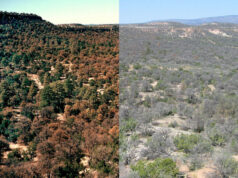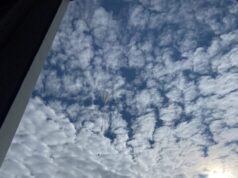Vaccines, Asteroids and Puppies: The Top UArizona Stories of 2021
From tracking the origins of the COVID-19 pandemic, to learning how puppies communicate, University of Arizona expertise in a variety of fields made international headlines in 2021.
Today
University Communications
Business and Law Campus News Health Science and Technology Social Sciences and Education
Adaptation Compassion Determination Exploration Inclusion Integrity
Media contact(s)
Nick Prevenas
Director, Media Relations, University Communications
Find your dream job in the space industry. Check our Space Job Board »
The University of Arizona made several significant research discoveries and celebrated some unprecedented successes in 2021.
Whether it was transforming the campus into a high-capacity COVID-19 vaccination site or casting mirrors that will help astronomers peer into the deepest corners of the universe, UArizona scientists, scholars and students made a lasting impact on the world this year.
Here are some of the university’s top stories of 2021:
COVID-19 Vaccinations Begin at UArizona: Jan. 19
For more than six months, the University of Arizona served as a point of distribution for COVID-19 vaccinations, administering nearly a quarter of a million doses. UArizona began in January as the designated distribution point for teachers and child care workers before shifting in February to a high-capacity state vaccination site serving all of southern Arizona. (The Associated Press, The Washington Post, USA Today)
OSIRIS-REx Spacecraft is Headed Home with Asteroid Sample: May 10
After nearly five years in space, the OSIRIS-REx spacecraft began its two-and-a-half-year journey back to Earth in May, with an abundance of rocks and dust from near-Earth asteroid Bennu. Dante Lauretta, UArizona Regents Professor of Planetary Sciences, is the principal investigator of the NASA mission, which will help scientists learn more about the formation and evolution of the solar system. (The New York Times, CNN, International Business Times)
Evidence Points to Animal Market, Not Lab, as Epicenter of Pandemic: Nov. 18
The Huanan Seafood Wholesale Market in Wuhan, China, has emerged as the most likely source of the COVID-19 outbreak, making a possible alternative explanation that the virus leaked from a research lab increasingly unlikely, according to a paper published in the journal Science by Michael Worobey, a virus evolution expert. (The New York Times, The Washington Post, Reuters)
Bear Down, Aari-zona! McDonald Makes Her Mark: March 31
In March, the UArizona women’s basketball team, under the leadership of head coach Adia Barnes, made its first Final Four appearance in program history. Three key plays from All-American Aari McDonald helped get the team there. (The Players Tribune, USA Today, FiveThirtyEight)
Puppies are Wired to Communicate With People, Study Shows: June 3
Dogs may have earned the title “man’s best friend” because of how good they are at interacting with people. Those social skills might be present shortly after birth rather than learned, a study by Arizona Canine Cognition Center researchers suggests. (BBC, NBC News, AFP France)
Sixth Mirror Casting Brings Giant Magellan Telescope Closer to Completion: March 5
Beneath the stands of Arizona Stadium, engineers with UArizona Richard F. Caris Mirror Lab manufacture the world’s largest and most lightweight telescope mirrors. At the center of the process is a giant spinning furnace, the only one of its kind. This year, the lab began casting the sixth of seven mirror segments for the Giant Magellan Telescope under construction in Chile’s Atacama Desert. The telescope will see farther into the universe and capture more detail than any optical telescope before. (NPR’s Science Friday, Engadget, Axios)
UArizona Astronomers to Help NASA’s James Webb Space Telescope Peer into Space’s Past: Oct. 12
Husband-and-wife astronomers George and Marcia Rieke are key players in NASA’s James Webb Space Telescope, set to launch Dec. 22. Webb will used its infrared “eyes” to peer deeper into the cosmos than any space telescope before. Marcia Rieke led the development of the telescope’s Near Infrared Camera, or NIRCam, and is principal investigator for the instrument. George Rieke is science team lead for the Mid-Infrared Instrument, or MIRI. (The New Yorker, The Conversation, The Daily Mail)
UArizona-Led Team Finds Nearly 500 Ancient Ceremonial Sites in Southern Mexico: Oct. 25
A team of international researchers led by UArizona reported in 2019 that they had uncovered the largest and oldest Maya monument – Aguada Fénix. That same team this year uncovered nearly 500 smaller ceremonial complexes that are similar in shape and features to Aguada Fénix. The find transforms previous understanding of Mesoamerican civilization origins and the relationship between the Olmec and Maya people. (Reuters, CNN, Business Insider)
Near-Earth Asteroid Might be a Lost Fragment of the Moon: Nov. 11
A near-Earth asteroid named Kamo`oalewa could be a fragment of our moon, according to a paper published in Communications Earth and Environment by a UArizona-led team of astronomers. (The New York Times, CBS News, TIME Magazine)
UArizona to Lead Mission to Discover Potentially Dangerous Asteroids: June 11
NASA has tasked Amy Mainzer, an expert in infrared astronomy at UArizona, with leading NEO Surveyor, a mission to find, track and characterize yet unseen asteroids and comets that may pose a threat to Earth. (CNN, The Washington Post, The Wall Street Journal)
Here are some additional stories that get honorable mention:
Engineers Propose Solar-Powered Lunar Ark as ‘Global Insurance Policy’: March 8
UArizona Launches Center to Advance Resilience of Native Nations, Address Environmental Challenges: Sept. 13
Global Temperatures Over Last 24,000 Years Show Today’s Warming ‘Unprecedented’: Nov. 10
UArizona Alumnus R. Ken Coit Commits $50M to Advance College of Pharmacy: Nov. 5
UArizona Names W.A. Franke Honors College in Recognition of $25M Gift: Oct. 9
Turning Cameras Off During Virtual Meetings Can Reduce Fatigue, UArizona Research Finds: Aug. 30
Like Venom Coursing Through the Body: Researchers Identify Mechanism Driving COVID-19 Mortality: Aug. 24
UArizona Art Exhibition Explores Universal Subject of Food: Oct. 19
COVID-19 Vaccine Reduces Severity, Length, Viral Load for Those Who Still Get Infected: July 30
Age of Empires IV Players Eligible for UArizona Credit Through History Department Collaboration: Nov. 19











